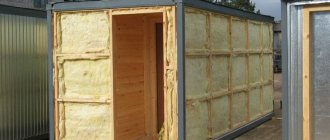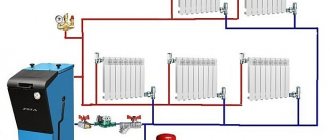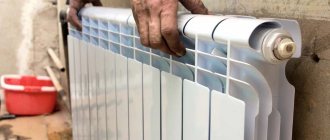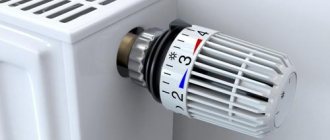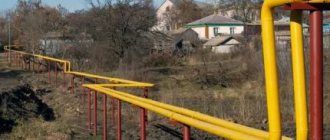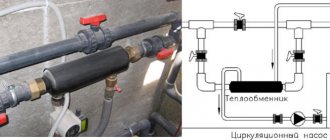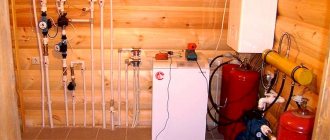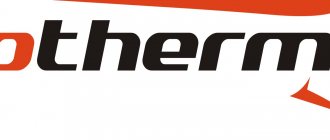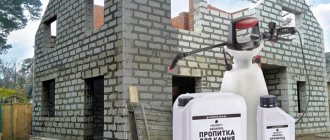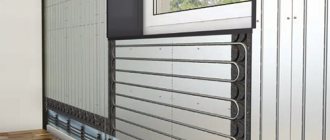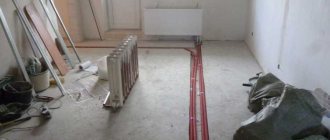Furnaces for heating cabins
If the change house has a sufficient area and requires long-term use, then installing a wood stove will be a good option. Hiring a craftsman and purchasing materials is not cheap, but in the long run the stove will pay for itself thanks to cheap firewood and good efficiency.
The disadvantage of a stationary stove is the inability to remove it after the end of the heating season.
Heating the cabin with electricity
Heating a cabin with electricity in winter breaks records of popularity. If you have access to electricity, then this method is easy to install, safe when used according to the instructions, and has a huge number of types of stoves and heaters. Many models have the ability to adjust the temperature.
Electric heating of the cabin is carried out using:
- mobile oil batteries (radiators);
- electric fireplaces (stoves) with imitation of live fire;
- convectors, which heat the room using air flow;
- film or infrared heaters.
The first and second options are not very good for heating a container, because such stoves and radiators heat up the space around them more. The far corners of the trailer will be cold, especially if the area is large. And the heating is slow. Considering that working outbuildings at the dacha are not used constantly and do not require round-the-clock temperature control, this will reduce comfort.
A convector that blows warm air into a room copes better with hard-to-reach places, but for uniform heating it is better to purchase several of these devices.
Film and infrared devices are compact, heat evenly, and are used for additional heating. Infrared heaters also do not dry out the air, which significantly increases the comfort of being in the trailer.
You can heat the room using an air conditioner. It must have a heating function, but even in this case it cannot heat in the same way as a stove. The difference between the temperature inside and outside the room should not be more than 10 degrees.
Disadvantages of electric heaters:
- Expensive. Electricity is not that cheap.
- Access to electricity. Not all cabins are equipped with this feature.
- Infrared devices do not heat the air itself, but the surfaces in the room, and then the objects give off heat. This is not always rational; there are few things in the room, and heating only the walls does not provide adequate heat.
But the devices do not require any additional purchase of fuel or particularly complex installation. They are safe, easy to use - you just need to plug them into the network.
Heating options
A prerequisite for using a heating device in a wooden or metal shed is the absence of open fire. This is a fire safety requirement, compliance with which will protect the health and lives of the inhabitants of the temporary building. The following types of heating devices are used to heat the cabin.
Gas heaters
The most efficient heating option. Low operating costs are achieved by low gas prices and highly efficient operation of the device. It is self-sufficient, since gas cylinders are used for operation. An additional advantage is the automatic operating mode, which is present in most heating devices. The disadvantages include the cost of purchasing at least two cylinders and relatively expensive heating equipment.
Electric heaters
The advantages of this heating method are:
- ease of management and use;
- a serious selection of heaters varying in power, heating area and cost;
- work in automatic mode.
The disadvantages of electric heating are the need to connect to an electrical supply, which is not present everywhere, and the high cost of electricity.
Solid fuel heaters
The main advantage of stoves operating on solid fuel, which is usually wood or coal, is the low cost and availability of the fuel used. As a bonus, there is no need to connect to the power supply network. The disadvantage of this type of heating is the responsibility of the owner of the cabin to constantly replenish fuel reserves, for the storage of which it is necessary to organize a special place.
Liquid fuel heaters
The operation scheme is similar to solid fuel heaters. The advantages are the availability and low cost of diesel fuel used as fuel, as well as operational efficiency. The downside is the need for storage capacity, which takes up a lot of space.
Heating with solid fuel
The so-called potbelly stove runs on wood or coal.
Due to emissions of combustion products, a chimney is required! This is the basic requirement. It is important to monitor safety - the stove is installed at a distance from the wall (at least 30 cm), the proximity of sleeping places is excluded, the stove should not interfere with the movement of people.
But the potbelly stove also has undeniable advantages. Cheap fuel allows you to use the device for a long time. Firewood is prepared for a long period of time.
If the stove runs on coal, it saves space; the fuel will take up less space.
This is the second most popular method after electric heaters.
Heating the cabin with gas
Gas is popular due to its efficiency (a cylinder is purchased once and refilled as needed), availability, a large number of models of heating devices and safety with proper use. In modern models, gas does not burn. Heating occurs due to fuel oxidation.
In winter, propane is used, but butane is also acceptable if the winter is warm (plus temperature) or the container is used only as a work space.
The body of the gas heater heats up slightly, which makes the device safe. It is necessary to have a thermostat and protection against fuel leakage.
Wooden cabins for the hot season
Garden change houses demonstrate a good ability to maintain a comfortable microclimate. Made of wood, lined with clapboard inside and out, these small structures can withstand heat well and do not require complex preservation for the winter. Moreover, unlike a standard container, such products have a ridge roof, which reflects part of the heat, and the space under it acts as a buffer zone. For a dacha and a small suburban area, this is a very convenient and relatively inexpensive solution.
If you think about the foundation for such a house in advance, then in the summer it will be partially ventilated from below, and in the winter it will not freeze. There are options for protecting the cabin floor from frost, but they should be discussed separately.
Preparing for insulation
If the trailer was not initially insulated, then in the cold weather it will have to be done. Without proper thermal insulation, any heating methods will be unnecessarily expensive. It will be needed for both wood and metal change houses. All surfaces (floor, walls, ceiling) are insulated; the ceiling and walls are sheathed either inside or outside.
Options for thermal insulation materials:
- Styrofoam;
- cotton insulator;
- mineral wool;
- polyurethane foam.
The first step is to select and purchase the material. The calculation of the area takes into account whether the room is sheathed outside or inside. When upholstering, space is eaten up inside, but you don’t have to worry about the impact of the environment on the material and appearance.
Polystyrene foam does not burn, does not allow moisture to pass through, and is light in weight. But it is destroyed by chemicals and does not tolerate the sun. Therefore, it will have to be plastered. It also does not bend, the rounded parts will not be protected.
Cotton insulation is environmentally friendly, easy to install, but difficult to cut.
Mineral wool is durable and soft, not flammable. It is easy to upholster due to its texture. When working with cotton wool, take precautions: protect the skin from the smallest fragments of the material, breathe through a respirator. The price is noticeably higher than polystyrene foam, but cheaper than cotton insulation.
Polyurethane foam is a synthetic material, relatively flammable and toxic, susceptible to destruction, but very easy to install. This compensates for its high cost. Toxic substances evaporate from it in a few days.
Thermal insulation is placed in a wooden or metal frame. The cleaned surface is treated with an antiseptic. Then a frame is made with cells 50x50 cm. The material is placed in them. For the work you will need screws, nails, a hammer, wood mastic, a stapler, and a vapor barrier.
When laying thermal insulation on the roof, the slate is removed.
Insulation of a cabin trailer
No heating device can effectively heat a room if there are cracks, leaks and drafts in the cabin. Therefore, it is necessary to first seal all joints and connections and ensure the integrity of the roof and floors. In case of long-term use in winter, it is advisable to equip the trailer with high-quality double-glazed windows and an insulated door. If the temporary shed is used in regions with harsh climatic conditions, then it would be advisable to cover its external walls with insulation.
Notes from personal experience about everything that may be of interest to many
Subscribe to this blog
Follow by Email
Winter heating test of a cabin
In the first days of January, real winter finally arrived - first the temperature became steadily negative, and then the snow began to fall. During the New Year holidays we decided to go to the dacha. Realizing that warming up the completely frozen cabin would take more than one hour in any case, we decided to leave in the morning so that by evening we could understand for sure whether it would be possible to spend the night comfortably with two-year-old Andryukha.
Upon arrival at the scene, the external temperature sensor in the car showed -16°C, and the alcohol thermometer inside the cabin showed -15°C. The heating was started at 12:45. The gas convector, as usual, took a very long time to start up. The pilot burner did not want to light up; it took several minutes to keep the valve pressed. But I had already gotten used to this feature and waited patiently. Finally, the burner ignited, a few more seconds for the flame sensor to warm up, and the main burner started. The power of the gas convector is 4.5 kW. In parallel with it, an electric fan heater with a power of 1.3 kW was immediately turned on. In total, 5.8 kW of power was turned on to heat 24 cubic meters. premises.
After about an hour, the air temperature in the corner of the hut farthest from the convector was already -5°C, and another hour later +5°C. That is, approximately 10 degrees per hour. After 4 hours from the start of heating, a comfortable temperature of +23°C was established, the electric fan heater was turned off. But the wooden furniture, mattress and bed linen were still noticeably cold. After another couple of hours they warmed up too.
In total, it took approximately 6 hours and about 32 kWh of power to completely warm up the cabin from -15°C to +23°C.
Around five in the evening we were almost sure that it would be warm to sleep. Although the floor was still cold, it was cold to walk even in wool socks. But around seven o’clock in the evening the floor finally warmed up to an acceptable temperature; it was bearable to walk even barefoot.
How to insulate and how to heat construction trailers
A metal trailer requires a thick layer of insulation, because it was not originally intended for use in the winter months. A minimum of 50 mm of good insulation will provide not only heat but also sound insulation.
You can also use insulation such as penoizol - with proper experience, it will provide excellent insulating properties. This is a liquid mixture that fills the walls of the trailer. It hardens quickly in the air; there is no need to make a wooden frame. But mineral wool is also good.
If electricity is available, then the heating issue is considered resolved - buy a heat gun, wall heater or stove. If there is no electricity, but there is a sufficiently powerful exhaust hood or ventilation, then gas or diesel heating will do. In terms of economy, multi-fuel devices attract attention.
Methods for insulating a cabin
You can insulate your shed using several options:
- universal insulating material isospan;
- thermal insulation Knauf;
- internal heat insulator devices;
- installation of external insulation;
- placement of insulation between walls (for frame cabins).
Methods of wall insulation
Insulating materials can be installed inside the walls only if the cabin was originally adapted for this. If such a possibility was not initially provided for, then it is almost impossible to change the finished design. If you insulate the walls from the inside, the usable area of the room decreases. Therefore, this option is not acceptable for buildings with small dimensions.
There are also thermal insulation materials that, due to their technical characteristics, cannot be installed inside buildings. Thus, you cannot choose a material for internal insulation if it can emit harmful substances during operation or if there are doubts about its environmental friendliness.
